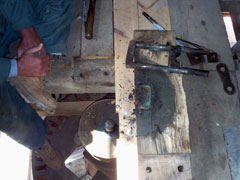Best viewed in landscape
Watermill Blog - Planning Consent
14th August 2008
The big news for this entry in our watermill blog is that we have been granted planning consent, or more correctly, listed building consent for everything we have applied for.
We had two application for consideration, the first being retrospective for the work we did to repair the hurst and the second being for items which we are sure used to exist but have no model for to be able to say we are repairing like for like.
This second application was for a cover over the "light well" by the side of the front door, a cover over the PTO shaft pit and finally a retaining wall beside the bottom door of the mill.
The bricklayers on the team now have a whole new wall to build, just as soon as they have finished the steps. The team joiner can now make the hatch to cover the light well and our welder can fabricate some grills for the PTO shaft cover. After all, we don't like our volunteers to feel unwanted.

The on-site team tackled a number of jobs today. Jonathan continued his bricklaying on the top of the stepped path and Dick mowed the grass.
Martyn, Max and Colin dismantled the top bearing to see if they could reduce the free play.
The picture shows the top of the centre shaft and the iron staple that holds the bearing blocks.
As the pin on the top of the centre shaft doesn't reach all the way through the bearing blocks we could effect a temporary repair by turning the blocks over so that the unworn portion comes into use. Temporary probably means thirty years or so in this case.
We ran the waterwheel to see if things had improved and a lot of the rattles have now gone. Colin and Bob took the opportunity to check out how the sack-hoist drive was running and spent some time fettling a few of the cogs as a result. We ran the wheel again to check their work and it is definitely improving.
It took all six of us to carry the newly donated length of lineshaft round to the workshop for cleaning up. The shaft has three small collars and two pulleys fixed along it. The collars moved relatively easily and we had moved one of the pulleys about an inch along the shaft before we ran out of time.
A combination of penetrating oil, heat and a sledgehammer were needed to achieve that movement but it should get easier as we get the pulley onto a cleaned up section of the shaft. The big surprise was that Richard had a hitherto unsuspected facility with a sledgehammer, obviously gained from his experience repairing old British motorcycles.
Go to the next Watermill Blog entry
Go to the previous Watermill Blog entry
Learn how to Support Us
Return to our Home Page